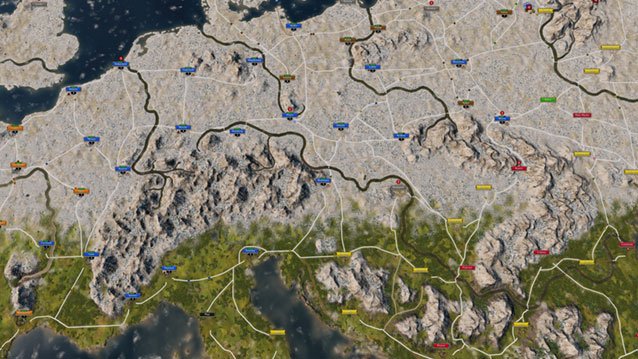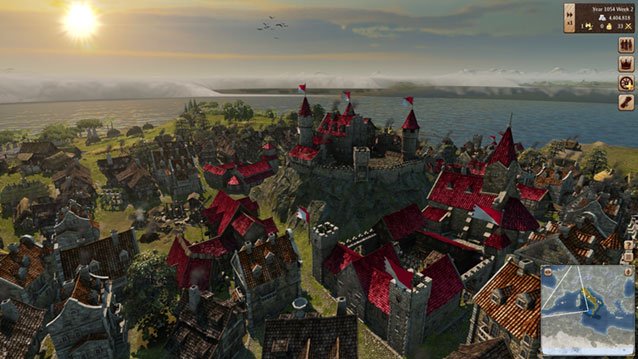


This is, I need to say up front, a review that I dragged my heels on writing. After getting review code well ahead of launch, I played a bit of it and simply couldn’t drag myself back to the game without reminding myself that I had a job to do. It’s a tough thing to say about something that has certainly been a labor of love for a group of devoted developers, but I’m afraid I cannot recommend the fruits of their work.
I fired Grand Ages: Medieval up, and immediately, everything about it put me off. There was a baffling launch menu that lets you confirm your decision to play the game using your controller’s A button, coupled with the fact that it offered no means to change any settings. There’s the game’s lack of ability to recognize laptop GPUs. And there’s the distinctively unlovely, pulled-from-the-original-Xbox art style. These all came together to make a very poor first impression, and after a couple tries, I wound up dawdling about actually putting any serious amount of time into the game.

Grand Ages: Medieval is a “grand strategy” game, insofar as that is an actual genre. PC gamers may be familiar enough with the term: it’s what we call every “big map” game that comes out of Paradox Interactive, notably the Crusader Kings and Europa Universalis series.
Your goal: Raise a feudal village up from nothing to European primacy by means of savvy use of exploitation of industry and trading with towns that need your products. If you can produce coal in your village, have a trader move it to a village where they can’t produce it: you’ll make a tidy sum.
It winds up being less about the 11th century and much more about running an Adam Smith-esque balance sheet, free of any of the cultural considerations that existed in the time or place the game purports to represent.

There’s a weirdly-off sense of scale, too – Grand Ages: Medieval’s Europe seems to be about as big as, say, Connecticut, where it’s possible to ride from the Black Sea to the Atlantic shores of Gaul in a couple in-game days. And where Crusader Kings kept players close to the reality of history, Grand Ages seems to use it primarily as window-dressing for its essentially context-free lesson in basic supply and demand economics. The campaign tells a story about a lordling who begins his career outside of Constantinople, but few of these elements translate into gameplay.
Which is not to say that it’s not worth playing, but you do need to get used to the game’s weird and often arbitrary rules. Once you do, though, there’s a counter-intuitive economic micromanagement system to navigate: You can increase production in a town near a natural resource by simply buying new businesses focused on that resource, but then you have to pay for each barrel of that resource produced, which is confusing — I’m to pay to set up storefronts and means of production, and then pay for all the products they create as well? This is how Grand Ages’ economy works, apparently.
The game rewards careful monitoring of production lines and trade routes, and it’s through these that you will prosper and eventually win. Working out what Grand Ages: Medieval has determined is the best way to strike economic balance winds up being most of the game, however.

You may not be surprised to find out that boiling international relations down to a fantastical and weird mercantilist supply and demand chain doesn’t paint a particularly realistic picture of the Middle Ages. There were politics, of course, and Grand Ages: Medieval more or less ignores them completely. Diplomacy is even more simplistic than it is in Civilization: Offer money, gain treaty.
That aside, managing your commodities once they’re on your town market is a chore as well. If you’re playing on PC, you can conveniently type in the amount of gold you’re willing to pay in order to establish a trade agreement with another village, but for some odd reason, you have to use an apparently logarithmic slider to tell your traders how many barrels of a commodity to buy and sell. The slider moves slowly for the first 10 or 20 percent of what’s available, and then immediately jumps to 100. You’ll have to do a lot of this, too, because buying low and selling high is the core mechanic of this game and will be the determining factor in whether you win or lose.
There is combat in the game, but it’s an afterthought and usually waste of time: Total War’s tactics are completely absent, and you’ll wind up in the early game with teams of scouts encountering gangs of, say, 20 lynxes that you have to run away from. (No one saw fit to tell the developers, it seems, that the European lynx is a solitary predator.)

You have no direct control over combat, and I feel the inclusion of these scenarios only makes Grand Ages look the worse in comparison to Civilization V. There’s no sense in trying to micromanage your armies or armadas in this game, because the winner always winds up being the player with more units.
I’ve said all this awful stuff about Grand Ages: Medieval, and I feel bad because there really is a solid game hiding underneath all these bizarre rules decisions and the homely, disjointed presentation. The use of 101-level supply and demand economics as core game mechanic is a good one, and Gaming Minds Studios has clearly put a lot of thought into the way the game works on a mechanical level.
It’s also a very daring move to release a game like this for PlayStation 4. While an analogue may exist in Japan, this is to my knowledge the only grand strategy game available for consoles in the west. For PC and Mac owners, there are tons of games that have done what Grand Ages: Medieval is doing much better than it does. However, this game will effectively stand alone on consoles when it launches for PS4, and may be worth a look for the PS4 owner looking for a more meditative, strategic game to play.
Grand Ages: Medieval was developed and published by Gaming Minds and published by Kalypso Media. It was released on September 25, 2015 via Steam on PC for $39.99, and on October 13 for the PlayStation 4 at an MSRP of $59.99. A copy was provided by the publisher for the purposes of review.




 Top 10 Funniest Patch Notes for The Sims 3
Top 10 Funniest Patch Notes for The Sims 3 Transformers: War for Cybertron PC Walkthrough
Transformers: War for Cybertron PC Walkthrough MGS V The Phantom Pain: How To Farm 7500 Fuel, 500 Precious Metal, 4000 Minor Metal Every 3 Minutes
MGS V The Phantom Pain: How To Farm 7500 Fuel, 500 Precious Metal, 4000 Minor Metal Every 3 Minutes Metal Gear Rising: Jetstream DLC Walkthrough & Collectibles Guide
Metal Gear Rising: Jetstream DLC Walkthrough & Collectibles Guide Round 2: Audio Logs in Watch Dogs
Round 2: Audio Logs in Watch Dogs